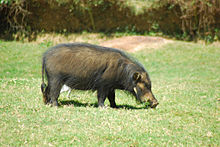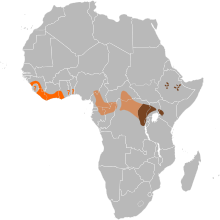Hylochoerus
| Giant forest hog | |
|---|---|
 |
|
 |
|
| Scientific classification | |
| Kingdom: | Animalia |
| Phylum: | Chordata |
| Class: | Mammalia |
| Order: | Artiodactyla |
| Family: | Suidae |
| Genus: |
Hylochoerus Thomas, 1904 |
| Species: | H. meinertzhageni |
| Binomial name | |
|
Hylochoerus meinertzhageni Thomas, 1904 |
|
 |
|
|
H. m. ivoriensis
H. m. rimator
H. m. meinertzhageni
|
|
The giant forest hog (Hylochoerus meinertzhageni), the only member of its genus, is native to wooded habitats in Africa and generally is considered the largest wild member of the pig family, Suidae; a few subspecies of the wild boar can reach an even larger size. Despite its large size and relatively wide distribution, it was first described only in 1904. The specific name honours Richard Meinertzhagen, who shot the type specimen in Kenya and had it shipped to the Natural History Museum in England.
The giant forest hog is, on average, the largest living species of suid. Adults can measure from 1.3 to 2.1 m (4 ft 3 in to 6 ft 11 in) in head-and-body length, with an additional tail length of 25 to 45 cm (9.8 to 17.7 in). Adults stand 0.75 to 1.1 m (2 ft 6 in to 3 ft 7 in) in height at the shoulder, and can weigh from 100 to 275 kg (220 to 606 lb). Females are smaller than males. Females weigh a median of approximately 167 kg (368 lb), as opposed to males, which weigh a median of 210 kg (460 lb). The eastern nominate subspecies is slightly larger than H. m. rimator of Central Africa and noticeably larger than H. m. ivoriensis of West Africa, with the latter sometimes being scarcely larger than related species such as the bushpig with a top recorded weight of around 150 kg (330 lb). The giant forest hog has extensive hairs on its body, though these tend to become less pronounced as the animal ages. It is mostly black in colour on the surface, though hairs nearest the skin of the animal are a deep orange colour. Its ears are large and pointy, and the tusks are proportionally smaller than those of the warthogs, but bigger than those of the bushpig. Nevertheless, the tusks of a male may reach a length of 35.9 centimetres (14.1 in).
...
Wikipedia

